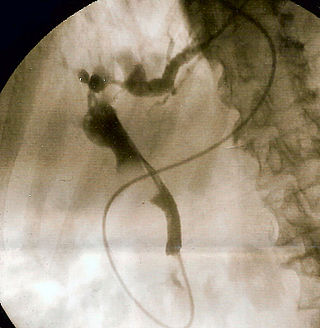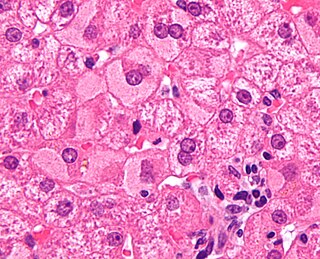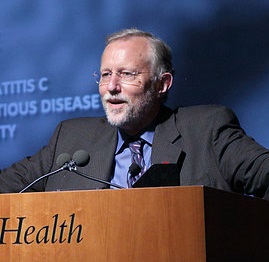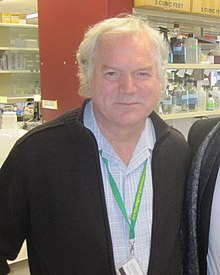
Hepatitis is inflammation of the liver tissue. Some people or animals with hepatitis have no symptoms, whereas others develop yellow discoloration of the skin and whites of the eyes (jaundice), poor appetite, vomiting, tiredness, abdominal pain, and diarrhea. Hepatitis is acute if it resolves within six months, and chronic if it lasts longer than six months. Acute hepatitis can resolve on its own, progress to chronic hepatitis, or (rarely) result in acute liver failure. Chronic hepatitis may progress to scarring of the liver (cirrhosis), liver failure, and liver cancer.

Hepatitis C is an infectious disease caused by the hepatitis C virus (HCV) that primarily affects the liver; it is a type of viral hepatitis. During the initial infection period, people often have mild or no symptoms. Early symptoms can include fever, dark urine, abdominal pain, and yellow tinged skin. The virus persists in the liver, becoming chronic, in about 70% of those initially infected. Early on, chronic infection typically has no symptoms. Over many years however, it often leads to liver disease and occasionally cirrhosis. In some cases, those with cirrhosis will develop serious complications such as liver failure, liver cancer, or dilated blood vessels in the esophagus and stomach.

Hepatology is the branch of medicine that incorporates the study of liver, gallbladder, biliary tree, and pancreas as well as management of their disorders. Although traditionally considered a sub-specialty of gastroenterology, rapid expansion has led in some countries to doctors specializing solely on this area, who are called hepatologists.

Hepatitis E is inflammation of the liver caused by infection with the hepatitis E virus (HEV); it is a type of viral hepatitis. Hepatitis E has mainly a fecal-oral transmission route that is similar to hepatitis A, although the viruses are unrelated. In retrospect, the earliest known epidemic of hepatitis E occurred in 1955 in New Delhi, but the virus was not isolated until 1983 by Russian scientists investigating an outbreak in Afghanistan. HEV is a positive-sense, single-stranded, nonenveloped, RNA icosahedral virus and one of five known human hepatitis viruses: A, B, C, D, and E.

Viral hepatitis is liver inflammation due to a viral infection. It may present in acute form as a recent infection with relatively rapid onset, or in chronic form.

The hepatitis C virus (HCV) is a small, enveloped, positive-sense single-stranded RNA virus of the family Flaviviridae. The hepatitis C virus is the cause of hepatitis C and some cancers such as liver cancer and lymphomas in humans.

Chiron Corporation was an American multinational biotechnology firm founded in 1981, based in Emeryville, California, that was acquired by Novartis on April 20, 2006. It had offices and facilities in eighteen countries on five continents. Chiron's business and research was in three main areas: biopharmaceuticals, vaccines, and blood testing. Chiron's vaccines and blood testing units were combined to form Novartis Vaccines and Diagnostics, while Chiron BioPharmaceuticals was integrated into Novartis Pharmaceuticals. In 2014, Novartis completed the sale of its blood transfusion diagnostics unit to Grifols and announced agreements for the sale of its vaccines unit to GlaxoSmithKline.

Harvey James Alter is an American medical researcher, virologist, physician and Nobel Prize laureate, who is best known for his work that led to the discovery of the hepatitis C virus. Alter is the former chief of the infectious disease section and the associate director for research of the Department of Transfusion Medicine at the Warren Grant Magnuson Clinical Center in the National Institutes of Health (NIH) in Bethesda, Maryland. In the mid-1970s, Alter and his research team demonstrated that most post-transfusion hepatitis cases were not due to hepatitis A or hepatitis B viruses. Working independently, Alter and Edward Tabor, a scientist at the U.S. Food and Drug Administration, proved through transmission studies in chimpanzees that a new form of hepatitis, initially called "non-A, non-B hepatitis" caused the infections, and that the causative agent was probably a virus. This work eventually led to the discovery of the hepatitis C virus in 1988, for which he shared the Nobel Prize in Physiology or Medicine in 2020 along with Michael Houghton and Charles M. Rice.

Hepatitis B vaccine is a vaccine that prevents hepatitis B. The first dose is recommended within 24 hours of birth with either two or three more doses given after that. This includes those with poor immune function such as from HIV/AIDS and those born premature. It is also recommended that health-care workers be vaccinated. In healthy people, routine immunization results in more than 95% of people being protected.

E1 is one of two subunits of the envelope glycoprotein found in the hepatitis C virus. The other subunit is E2. This protein is a type 1 transmembrane protein with a highly glycosylated N-terminal ectodomain and a C-terminal hydrophobic anchor. After being synthesized the E1 glycoproteins associates with the E2 glycoprotein as a noncovalent heterodimer.
A hepatitis C vaccine, a vaccine capable of protecting against the hepatitis C virus (HCV), is not yet available. Although vaccines exist for hepatitis A and hepatitis B, development of an HCV vaccine has presented challenges. No vaccine is currently available, but several vaccines are currently under development.
Stuart C. Ray is an American physician. He is Vice Chair of Medicine for Data Integrity and Analytics, Associate Director of the Infectious Diseases Fellowship Training Program at the Johns Hopkins School of Medicine, and a Professor in the Department of Medicine, Division of Infectious Diseases. Ray also holds appointments in Viral Oncology and the Division of Health Sciences Informatics. He is affiliated with the Institute for Computational Medicine at Johns Hopkins and is licensed to practice medicine in Maryland.
Infections of the hepatitis C virus (HCV) in children and pregnant women are less understood than those in other adults. Worldwide, the prevalence of HCV infection in pregnant women and children has been estimated to 1-8% and 0.05-5% respectively. The vertical transmission rate has been estimated to be 3-5% and there is a high rate of spontaneous clearance (25-50%) in the children. Higher rates have been reported for both vertical transmission. and prevalence in children (15%).
Qui-Lim Choo is a Singapore-born scientist, who along with Michael Houghton, George Kuo and Daniel W. Bradley, co-discovered and cloned Hepatitis C in 1989. He also co-discovered the Hepatitis D genome in 1986. The discovery of Hepatitis C led to the rapid development of diagnostic reagents to detect Hepatitis C virus in blood supplies which has reduced the risk of acquiring hepatitis C through blood transfusion from one in three to about one in two million. It is estimated that antibody testing has prevented at least 40,000 new infections per year in the US alone and many more worldwide.
Daniel W. Bradley is an important American virologist who, along with Michael Houghton, Qui-Lim Choo and George Kuo at Chiron Corporation, worked to help isolate the Hepatitis C virus in 1989. He graduated from San José State University in 1964 before going on to receive a master's degree in biochemistry from the University of California and a doctorate from the University of Arizona. He worked for the Centers for Disease Control and Prevention starting in 1971. He received the Karl Landsteiner Memorial Award of the American Association of Blood Banks in 1992, the Robert Koch Prize in 1993, and the Gairdner Foundation International Award in 2013.
George Ching-Hung Kuo is a Taiwanese-born scientist, who along with Michael Houghton, Qui-Lim Choo and Daniel W. Bradley, co-discovered and cloned the hepatitis C virus in 1989.
Stephen Mark Feinstone is a virologist who, together with Albert Kapikian and Robert Purcell, co-identified the Hepatitis A virus (HAV) in 1973.

Charles Moen Rice is an American virologist and Nobel Prize laureate whose main area of research is the hepatitis C virus. He is a professor of virology at the Rockefeller University in New York City and an adjunct professor at Cornell University and Washington University School of Medicine. At the time of the award he was a faculty at Rockefeller.
HPgV-2 is the second human pegivirus discovered. It was first identified in 2005 in blood of transfusion recipients and initially named hepegivirus 1 because it shared some genetic features with both pegiviruses and hepaciviruses. HPgV-2 was later independently discovered by another group in the blood of a HCV-infected patient who had undergone multiple blood transfusions and died from sepsis of unclear etiology. It was then named human pegivirus 2. HPgV-2 is now classified in the pegivirus genus as part of Pegivirus H species.
The 2020 Nobel Prize in Physiology or Medicine was awarded to the American virologists Harvey J. Alter, Michael Houghton and Charles M. Rice "for the discovery of Hepatitis C virus." During the award ceremony on December 10, 2020, Prof. Gunilla Karlsson-Hedestam said:
"The discovery of the Hepatitis C virus by this year’s Laureates laid the foundation for our current understanding about how the virus survives in its niche during the long chronic phase of the infection, and how liver disease develops. And importantly, it led to the development of highly effective anti-viral medicines that now cure the infection in almost all treated persons."











